
HMS Queen Mary was the last battlecruiser built by the Royal Navy before the First World War. The sole member of her class, Queen Mary shared many features with the Lion-class battlecruisers, including her eight 13.5-inch (343 mm) guns. She was completed in 1913 and participated in the Battle of Heligoland Bight as part of the Grand Fleet in 1914. Like most of the modern British battlecruisers, the ship never left the North Sea during the war. As part of the 1st Battlecruiser Squadron, Queen Mary attempted to intercept a German force that bombarded the North Sea coast of England in December 1914, but was unsuccessful. The ship was refitting in early 1915 and missed the Battle of Dogger Bank in January, but participated in the largest fleet action of the war, the Battle of Jutland in mid-1916. She was hit twice by the German battlecruiser Derfflinger during the early part of the battle and her magazines exploded shortly afterwards, sinking the ship.

The Nelson class was a class of two battleships of the British Royal Navy, built shortly after, and under the terms of, the Washington Naval Treaty of 1922. They were the only British battleships built between the Revenge class and the King George V class, ordered in 1936.

The Renown class consisted of two battlecruisers built during the First World War for the Royal Navy. They were originally laid down as improved versions of the Revenge-class battleships, but their construction was suspended on the outbreak of war on the grounds they would not be ready in a timely manner. Admiral Lord Fisher, upon becoming First Sea Lord, gained approval to restart their construction as battlecruisers that could be built and enter service quickly. The Director of Naval Construction (DNC), Eustace Tennyson-D'Eyncourt, quickly produced an entirely new design to meet Admiral Lord Fisher's requirements and the builders agreed to deliver the ships in 15 months. They did not quite meet that ambitious goal, but they were delivered a few months after the Battle of Jutland in 1916. They were the world's fastest capital ships upon their commissioning.
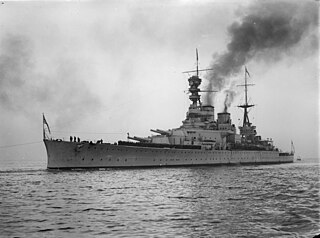
HMS Renown was the lead ship of her class of battlecruisers of the Royal Navy built during the First World War. She was originally laid down as an improved version of the Revenge-class battleships. Her construction was suspended on the outbreak of war on the grounds she would not be ready in a timely manner. Admiral Lord Fisher, upon becoming First Sea Lord, gained approval to restart her construction as a battlecruiser that could be built and enter service quickly. The Director of Naval Construction (DNC), Eustace Tennyson-D'Eyncourt, quickly produced an entirely new design to meet Admiral Lord Fisher's requirements and the builders agreed to deliver the ships in 15 months. They did not quite meet that ambitious goal, but the ship was delivered a few months after the Battle of Jutland in 1916. Renown, and her sister HMS Repulse, were the world's fastest capital ships upon completion.
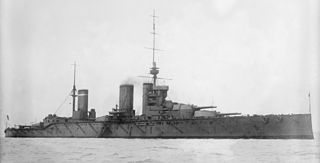
The Lion class were a pair of battlecruisers built for the Royal Navy before World War I. Nicknamed the "Splendid Cats", the ships were a significant improvement over their predecessors of the Indefatigable class in speed, armament and armour. These improvements were in response to the German battlecruisers of the Moltke class, which were in turn larger and more powerful than the first British battlecruisers of the Invincible class.

The Courageous class consisted of three battlecruisers known as "large light cruisers" built for the Royal Navy during the First World War. The class was nominally designed to support the Baltic Project, a plan by Admiral of the Fleet Lord Fisher that was intended to land troops on the German Baltic Coast. Ships of this class were fast but very lightly armoured, with only a few heavy guns. They were given a shallow draught, in part to allow them to operate in the shallow waters of the Baltic but also reflecting experience gained earlier in the war. To maximize their speed, the Courageous-class battlecruisers were the first capital ships of the Royal Navy to use geared steam turbines and small-tube boilers.

The three Invincible-class battlecruisers were built for the Royal Navy and entered service in 1908 as the world's first battlecruisers. They were the brainchild of Admiral Sir John ("Jacky") Fisher, the man who had sponsored the construction of the world's first "all-big-gun" warship, HMS Dreadnought. He visualised a new breed of warship, somewhere between the armoured cruiser and battleship; it would have the armament of the latter, but the high speed of the former. This combination would allow it to chase down most ships, while allowing it to run from more powerful designs.

The Indefatigable class were the second class built of British battlecruisers which served in the Royal Navy and the Royal Australian Navy during World War I. The design represented a modest reworking of the preceding Invincible class, featuring increased endurance and an improved cross-deck arc of fire for their midships wing turrets achieved by a lengthening of the hull. Like its predecessor, the design resembled the contemporary dreadnought of the Royal Navy, but sacrificed armour protection and one turret from the main battery for a 4-knot speed advantage.

The Minotaur class was a three-ship class of armoured cruisers built in the first decade of the twentieth century for the Royal Navy. These were the last class of armoured cruisers built for the Royal Navy, with that role being substantially replaced by the first battlecruisers. These initially served with the Home Fleet, generally as the flagships of cruiser squadrons. Minotaur became flagship of the China Station in 1910 and Defence served as flagship of the 1st Cruiser Squadron in the Mediterranean from 1912; Shannon remained at home as flagship of several different squadrons.

The Duke of Edinburgh-class cruiser was a class of two armoured cruisers built for the Royal Navy in the first decade of the 20th century. They were the first British armoured cruisers designed to work with the battlefleet rather than protect merchant shipping. After commissioning, they were assigned to the Atlantic, Channel and Home Fleets until 1913 when they were transferred to the Mediterranean Fleet. After the start of World War I in August 1914, the sister ships participated in the pursuit of the German battlecruiser SMS Goeben and light cruiser SMS Breslau. After the German ships reached their refuge in Ottoman Turkey, the ships were ordered to the Red Sea for convoy escort duties. They captured three German merchant ships before they returned to home at the end of the year.
The Admiral-class battlecruisers were to have been a class of four British Royal Navy battlecruisers built near the end of World War I. Their design began as an improved version of the Queen Elizabeth-class battleships, but it was recast as a battlecruiser after Admiral John Jellicoe, commander of the Grand Fleet, pointed out that there was no real need for more battleships, but that a number of German battlecruisers had been laid down that were superior to the bulk of the Grand Fleet's battlecruisers and the design was revised to counter these. The class was to have consisted of HMS Hood, Anson, Howe, and Rodney — all names of famous admirals — but the other three ships were suspended as the material and labour required to complete them was needed for higher-priority merchantmen and escort vessels. Their designs were updated to incorporate the lessons from the Battle of Jutland, but the Admiralty eventually decided that it was better to begin again with a clean-slate design so they were cancelled in 1919. No more battlecruisers would be built due to the arms limitations agreements of the interbellum.

The Lion class was a class of six fast battleships designed for the Royal Navy (RN) in the late 1930s. They were a larger, improved version of the preceding King George V class, with 16-inch (406 mm) guns. Only two ships were laid down before the Second World War began in September 1939 and a third was ordered during the war, but their construction was suspended shortly afterwards. The design was modified in light of war experience in 1942, but the two ships already begun were scrapped later in the year.

The G3 class was a class of battlecruisers planned by the Royal Navy after the end of World War I in response to naval expansion programmes by the United States and Japan. The four ships of this class would have been larger, faster and more heavily armed than any existing battleship. The G3s have been considered to be proper "fast battleships" since they were well-balanced designs with adequate protection. Nonetheless the class was officially designated as a "battlecruiser" due to their higher speed and lesser firepower and armour relative to the planned N3-class battleship design. The G3s would have carried nine 16-inch (406 mm) guns and were expected to achieve 32 knots, while the N3s would carry nine 18-inch (457 mm) guns on the same displacement at the expense of speed.

The Evstafi class were a pair of pre-dreadnought battleships of the Imperial Russian Navy built before World War I for the Black Sea Fleet. They were slightly enlarged versions of the Russian battleship Potemkin, with increased armour and more guns. Numerous alterations were made as a result of experience in the Russo-Japanese War of 1904–5 that seriously delayed the completion of the two ships.
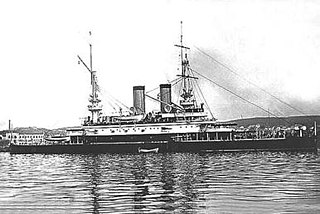
Tri Sviatitelia was a pre-dreadnought battleship built for the Imperial Russian Navy during the 1890s. She served with the Black Sea Fleet and was flagship of the forces pursuing the mutinous battleship Potemkin in June 1905. During World War I the ship encountered the German battlecruiser SMS Goeben twice, but never hit the German ship, nor was she damaged by her. From 1915 onward she was relegated to the coast bombardment role as she was the oldest battleship in the fleet. Tri Sviatitelia was refitting in Sevastopol when the February Revolution of 1917 began and she was never operational afterwards.
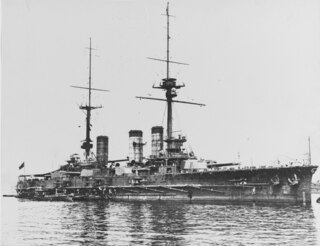
The Satsuma class was a pair of semi-dreadnought battleships built for the Imperial Japanese Navy (IJN) in the first decade of the 20th century. They were the first battleships to be built in Japan and marked a transitional stage between the pre-dreadnought and true dreadnought designs. They saw no combat during World War I, although Satsuma led a squadron that occupied several German colonies in the Pacific Ocean in 1914. Both ships were disarmed and expended as targets in 1922–1924 in accordance with the terms of the Washington Naval Treaty of 1922.

The Lexington-class battlecruisers were officially the only class of battlecruiser to ever be ordered by the United States Navy. While these six vessels were requested in 1911 as a reaction to the building by Japan of the Kongō class, the potential use for them in the U.S. Navy came from a series of studies by the Naval War College which stretched over several years and predated the existence of the first battlecruiser, HMS Invincible. The fact they were not approved by Congress at the time of their initial request was due to political, not military considerations.

The Ibuki class, also called the Kurama class, was a ship class of two large armoured cruisers built for the Imperial Japanese Navy after the Russo-Japanese War of 1904–1905. These ships reflected Japanese experiences during that war as they were designed to fight side-by-side with battleships and were given an armament equal to, or superior to existing Japanese battleships. The development of the battlecruiser the year before Ibuki was completed made her and her sister ship Kurama obsolete before they were completed because the foreign battlecruisers were much more heavily armed and faster.
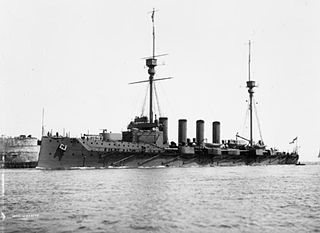
The Warrior class consisted of four armoured cruisers built for the Royal Navy in the first decade of the 20th century. After commissioning, all four sister ships were assigned to the Channel and Home Fleets until 1913 when Warrior was transferred to the Mediterranean Fleet. After the start of World War I in August 1914, Warrior participated in the pursuit of the German battlecruiser SMS Goeben and light cruiser SMS Breslau and her three sisters were assigned to the 2nd Cruiser Squadron of the Grand Fleet. Warrior joined the 1st Cruiser Squadron of the Grand Fleet in late 1914. Neither squadron participated in any of the naval battles in the North Sea in 1915. Natal was destroyed by a magazine explosion in late 1915 and only two of the ships participated in the Battle of Jutland in 1916. Cochrane was not engaged during the battle, but Warrior was heavily damaged and sank the following morning.
The J3 class battlecruiser was a design study conducted during the Royal Navy's 1921 Fleet modernization programme. As a follow-on to the Admiral-class battlecruiser, the J3 class incorporated all the lessons learned from the First World War, specifically the battle of Jutland. The design was seen as an improvement to the Admiral class by virtue of its heavier and improved armouring scheme, specifically the deck armour, although the offensive armament remained roughly the same. The design was superseded by the I3 and G3 battlecruiser designs, as both mounted a heavier main armament, and further improved the protection scheme, on roughly the same tonnage. The 1921 fleet program was cancelled due to signing of the Washington Naval Treaty in 1922, which limited the size and armament of battleships to 35,000 long tons (36,000 t) and no gun bigger than 16 inches (406 mm).


















